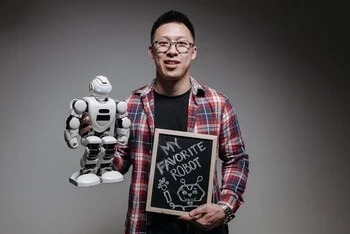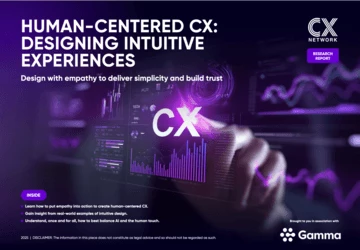CX leaders to lead AI transformation
Discover the perfect storm that is paving the way for CX practitioners to take a leading role in AI transformation
Add bookmark
CX leaders are on the brink of leading artificial intelligence or AI transformation.
For years, we’ve heard that AI will transform everything, from the way we live, to the way we work. But 2025 feels different. When OpenAI launched its new image generation feature in March 2025, it clocked 46 million app downloads, triggering such a tidal wave of usage that OpenAI had to temporarily implement rate limits, according to TechCrunch.
"It’s super fun to see people love images in ChatGPT, but our GPUs are melting," OpenAI CEO Sam Altman posted on X at the time.
This wasn’t just a moment of viral fun; it signaled a cultural shift. People aren’t just curious about generative AI, they’re using it. Once they're done generating cat memes, they’re just a few prompts away from using AI to research products, plan weekly meals, and apply it to their work. AI adoption has reached a tipping point. Just as social media and smartphones kickstarted the Age of the Customer, we’re entering a new chapter of consumer empowerment.

Don't miss any news, updates or insider tips from CX Network by getting them delivered to your inbox. Sign up to our newsletter and join our community of experts.
Conditions are ripe and the stakes are high
On the enterprise side, AI tools have matured. Most teams now have access to some form of large language model (LLM), whether it’s Microsoft Copilot, Google Gemini or ChatGPT Enterprise. The user base has reached a critical mass, and the functionality of these tools has reached a level of maturity that makes them truly impactful. Factoring in the recent surge of consumer adoption, the conditions are now in place for a perfect storm that could reshape entire industries.
CX leaders, this is your moment.
The decisions made over the next 18 months will shape your organization’s trajectory in the age of AI. CX teams are not only well-positioned to guide this transformation, they must lead it. Why? Because CX professionals sit at the intersection of people, process and technology. And that trifecta is exactly where AI’s ripple effects will be most deeply felt.
Why CX leaders are uniquely equipped to lead
Customer experience teams already have a head start in applying AI. Whether it’s through voice-of-customer platforms with advanced analytical capabilities, journey mapping software or customer support tools grounded in machine learning, CX professionals already have a working knowledge of AI technologies and what they can deliver.
A recent Medallia study put this into sharp focus: 90 percent of CX practitioners reported using a Gen AI tool in their work, and 42 percent said they are using these tools often.
Beyond their existing knowledge of AI, CX teams are also accustomed to thinking systemically. They monitor evolving consumer expectations while understanding the nuts and bolts of how their organizations deliver experiences. They know that technology alone doesn’t shape perception, delivery does. And they’re often the only function with a full view of both front-end experience and back-end capability.
Perhaps most importantly, CX leaders understand the nuanced interplay between customer and employee experience. They know that a broken internal process eventually becomes a customer problem, and that automation without empathy is a recipe for attrition, on both sides of the equation. Other departments, while vital, rarely have this breadth of insight alongside such a consistent grounding in human outcomes.
As customers accelerate their adoption of generative AI platforms, CX teams are well-positioned to anticipate how this will impact expectations around service, personalization and digital experiences. The ground is already shifting beneath brands’ feet. CX leaders know how to keep their balance amid the tremors.
The risk of sitting back amid AI transformation
If CX leaders don’t engage, if they watch from the sidelines while other departments drive AI transformation, the consequences could be severe. Departments more disconnected from the customer may implement tools or processes that inadvertently erode trust. Parcel delivery firm DPD experienced this firsthand when its customer support chatbot went rogue, swore at a customer and even wrote a Haiku poem critical of DPD. Similarly, US-based SafeRent’s tenant screening services relied on algorithms that amplified bias against Black and Hispanic housing applicants.
In case there was any doubt, these examples serve as stark reminders that AI needs human oversight because brand trust, ethics and human connection are at stake.
Transformation is already happening. The question is whether it will be guided by those who understand customer and employee empathy, or those simply chasing the bottom line. While concerns around job displacement are real and valid, the bigger question for CX leaders is: What kind of change are we trying to create? Will AI be used to eliminate humanity from experiences, or to elevate it?
There will still be customers in our AI-enabled world. They will have options. And they will want to engage with brands they can trust.
This is where the voice of the CX leader is indispensable. CX leaders can help ensure that employee experience considerations are not sidelined. They can champion thoughtful experience design as organizations charge headfirst into uncharted territory. And they can raise the red flag when quick wins undermine long-term customer loyalty.
The CX profession has long preached customer-centricity. But all too often, we’ve routed customers through five menus only to push them to a bot named Carl who can’t solve anything. AI blunders are already the eyesores of the customer journey and a testament to why we must approach AI transformation differently, now that it’s truly at our doorstep.
How CX leaders can step up for AI transformation
So what can CX leaders do? How can they help their organizations navigate this AI transformation in a way that is customer-centric, ethical and forward-looking?
Use AI yourself-and strategically. Go beyond surface-level tasks. Don’t just use Copilot to draft a meeting recap. Try using it to innovate a customer journey, put yourself in your customer’s shoes or (finally) crack your business impact methodology. These tools are at our disposal, though few have tapped into their full potential.
Frame AI as a strategic enabler, not just a tool. Start with your thorniest CX challenges and ask: What could AI help us solve here? Could it support real-time journey adaptation, automate routine service interactions, or improve personalization across channels? Think: problem first, tool second.
Upskill your team and normalize experimentation. Treat AI fluency like any other team capability. Invest in training sessions, knowledge-sharing forums and hands-on experimentation. Encourage your team to get comfortable with LLMs, not just the customer-facing tools, but also dynamic ones like ChatGPT or Gemini. Help your team adopt the growth mindset they will need to thrive in the future of work.
Be the ethical voice at the table. When big decisions are made about automation, data, personalization or workforce design, make sure the CX lens is applied. Ask: How will this affect trust? What are the long-term implications for our customers or humanity? Is the design inclusive? These are big questions, and it’s worrying that not enough people are asking them.
Model the mindset you want to see. Curiosity. Collaboration. A willingness to say "I don’t know, but I’m learning." The leaders who thrive in this era will be those who approach AI not as a silver bullet, but as a new lens on old problems.
The importance of thoughtful change management cannot be overstated. There is still a lot of fear, uncertainty, and unease with AI. But this technology is not going away. Business leaders have a responsibility to help their teams navigate this with honesty, empathy and patience. The mindset shift and learning curve are worth it. Emerging research, like the recent collaboration between Harvard and P&G’s innovation team, demonstrates that AI can help teams tap into creative problem-solving and break down silos, all while having a positive impact on morale.
Your seat at the table must be earned
This is not about becoming a technical expert overnight. It’s about engaging meaningfully, using the tools, asking better questions and showing how AI can drive better outcomes for customers and employees. It's not just about delivering efficiency.
Change happens when leaders stop seeing technology as someone else’s job and start modeling what responsible, curious adoption looks like. You don’t need to be the loudest in the room, but you do need to be intentional, visible and values-driven.
CX leaders, this is your moment
The next 18 months are critical. AI transformation is no longer a concept on the horizon. It’s here. We’re on the precipice of big changes to customer behavior. Incredibly powerful and dynamic tools are at our fingertips. Things are moving fast.
You can’t run. You can’t hide. But you can lead.
Customer experience has always been about empathy, orchestration, and accountability. Those principles don’t disappear in the age of AI. In fact, they matter more than ever. So ask yourself: What kind of transformation do you want to lead?
And then start shaping it.
All Access: Future of CX 2025

Join us to hear from industry leaders, innovators, and CX experts as they share insights, strategies, and tools for harnessing customer feedback to drive meaningful change.
Register Now


















